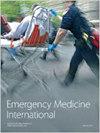COVID-19 期间台北地区紧急医疗系统的突发能力:系统动力学方法
IF 0.8
4区 医学
Q3 EMERGENCY MEDICINE
引用次数: 0
摘要
背景。COVID-19 在社区的传播导致地区紧急医疗系统(REMS)瘫痪,影响了地区急重症患者的权益和护理。本研究提出了一个区域紧急医疗系统快速反应能力模型,以便在能力超负荷的挑战性事件中做好准备和规划。方法。研究了 COVID-19 大流行期间急诊急救系统的激增能力。数据收集包括 26 家接收数据的医院。为模拟台北市急救医疗系统激增能力的动态变化,我们观察了其治疗 COVID-19 中度至重度急性呼吸窘迫综合症(ARDS)患者的能力。这将涉及监测子系统循环中呼吸机、医生和护士的库存。结果。医疗保健管理人员和行政人员可以利用超负荷模型和假设情景,开发出对激增能力有不同需求的新情景。REMS 系统容量模型可用作指导规划和交叉检查地址准备计划的辅助工具。结论。我们在模拟中结合了有关呼吸机、医生、护士、专科病床和普通急诊病床可用性的数据。因此,在完善的地区指挥和管理结构的支持下,我们的模拟可以帮助 REMS 达到最佳的增援能力。本文章由计算机程序翻译,如有差异,请以英文原文为准。
Surge Capacity of Taipei’s Regional Emergency Medical System during COVID-19: A System Dynamics Approach
Background. The community transmission of COVID-19 has caused the breakdown of the regional emergency medical system (REMS), impacting the rights and care of regional patients with acute and severe conditions. This study proposes a model for the surge capacity of REMS to plan for readiness and preparedness during challenging events that overload capacity. Methods. The surge capacity of REMS during the COVID-19 pandemic was studied. The data collection included 26 hospitals that received the data. To simulate the dynamics of Taipei’s REMS surge capacity, we observed its ability to treat COVID-19 patients with moderate to severe acute respiratory distress syndrome (ARDS). This will involve monitoring the stock of ventilators, physicians, and nurses within the subsystem loops. Results. Healthcare managers and administrators can use the overload model and hypothetical scenarios to develop new scenarios with different demands on surge capacity. The REMS system capacity model can be used as an aid to guide planning and cross-checking for address Prepare to plan. Conclusions. We combined data regarding the availability of ventilators, physicians, nurses, specialized beds, and general acute care beds in our simulations. Thus, our simulations, with support from a well-established regional command and management structure, could help REMS achieve the optimal surge capacity.
求助全文
通过发布文献求助,成功后即可免费获取论文全文。
去求助
来源期刊

Emergency Medicine International
EMERGENCY MEDICINE-
CiteScore
0.10
自引率
0.00%
发文量
187
审稿时长
17 weeks
期刊介绍:
Emergency Medicine International is a peer-reviewed, Open Access journal that provides a forum for doctors, nurses, paramedics and ambulance staff. The journal publishes original research articles, review articles, and clinical studies related to prehospital care, disaster preparedness and response, acute medical and paediatric emergencies, critical care, sports medicine, wound care, and toxicology.
 求助内容:
求助内容: 应助结果提醒方式:
应助结果提醒方式:


